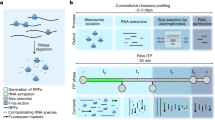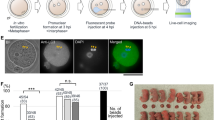Abstract
TRANSLATION of mRNA in egg cells and oocytes of Xenopus laevis Daudin has been shown to be very efficient for mRN As from a variety of cells1–7 and has uses in developmental biology, molecular biology and immunology8. We have also reported its use in cancer research9. One of the main disadvantages of this tool, however, is the fact that fairly extensive RNA extraction and purification procedures are required. In particular, in cases when different cell types are mixed, as in the case with immunologically active cells, it is almost impossible to obtain information about the activity of the separate cell types. Studies in this field are always dealing with, at best, highly enriched cell populations. Therefore we have looked for a method which avoids RNA extraction and purification, with the aim of being able to work with separate cells. We have tried to inject cell homogenates directly into egg cells of Xenopus, and in the experiments reported here, we chose myeloma cells (LOU/M/WS1 rats with myeloma IR2 synthesising immunoglobulin E), because we could analyse the translation products easily and we could start with a relatively homogeneous cell population. Our results suggest that it is possible to study the translation products of single myeloma cells using this technique.
This is a preview of subscription content, access via your institution
Access options
Subscribe to this journal
Receive 51 print issues and online access
$199.00 per year
only $3.90 per issue
Buy this article
- Purchase on Springer Link
- Instant access to full article PDF
Prices may be subject to local taxes which are calculated during checkout
Similar content being viewed by others
References
Gurdon, J. B., Lane, C. D., Woodland, H. R. & Marbaix, G. Nature 233, 177–182 (1971).
Lane, C. D., Marbaix, G. & Gurdon, J. B. J. molec. Biol. 61, 73–91 (1971).
Moar, V. A., Gurdon, J. B. & Lane, C. D. J. molec. Biol. 61, 93–103 (1971).
Gurdon, J. B., Woodland, H. R. & Lingrel, J. B. Devl Biol. 39, 125–133 (1974).
Woodland, H. R., Gurdon, J. B. & Lingrel, J. B. Devl Biol. 39, 134–140 (1974).
Knowland, J. Genetics 78, 383–394 (1974).
Donk, J. A. W. M. van der Nature 256, 674–675 (1975).
Stevens, R. H. & Williamson, A. R. Nature 239, 143–146 (1972).
Donk, J. A. van der, Dam, R. H. van, Goudswaard, J., Hackeng, W. & Lips, C. Lancet ii, 1133 (1976).
Bazin, H., Beckers, A., Deckers, C. & Moriamé, M. J. natn. Cancer Inst. 51, 1359 (1973).
Dam, R. H. van, Borst-van Werkhoven, C., Donk, J. A. van der & Goudswaard, J. J. Immunogenet. 3, 237–244 (1976).
Donk, J. A. W. M. van der Molec. gen. Genet. 131, 1–8 (1974).
Bazin, H. & Becker, A. in Molecular biological aspects of the acute allergic reaction (eds Johansson, S. G. O., Strandberg, K. & Uvnas, B.) (Plenum, London, 1976).
Bonner, W. M. & Laskey, R. A. Eur. J. Biochem. 46, 83–88 (1974).
Author information
Authors and Affiliations
Rights and permissions
About this article
Cite this article
VAN DER DONK, J., VAN DAM, R. & BAZIN, H. The use of Xenopus egg cells to assay the mRNA of single cells. Nature 271, 479–481 (1978). https://doi.org/10.1038/271479a0
Received:
Accepted:
Issue Date:
DOI: https://doi.org/10.1038/271479a0
Comments
By submitting a comment you agree to abide by our Terms and Community Guidelines. If you find something abusive or that does not comply with our terms or guidelines please flag it as inappropriate.



